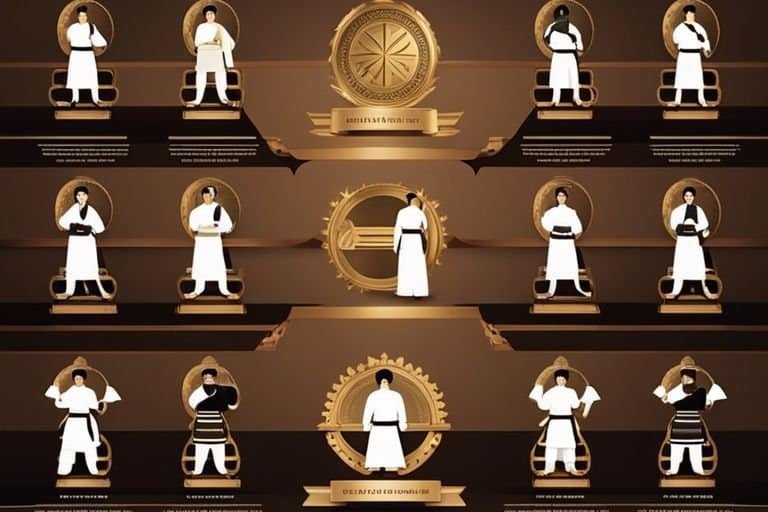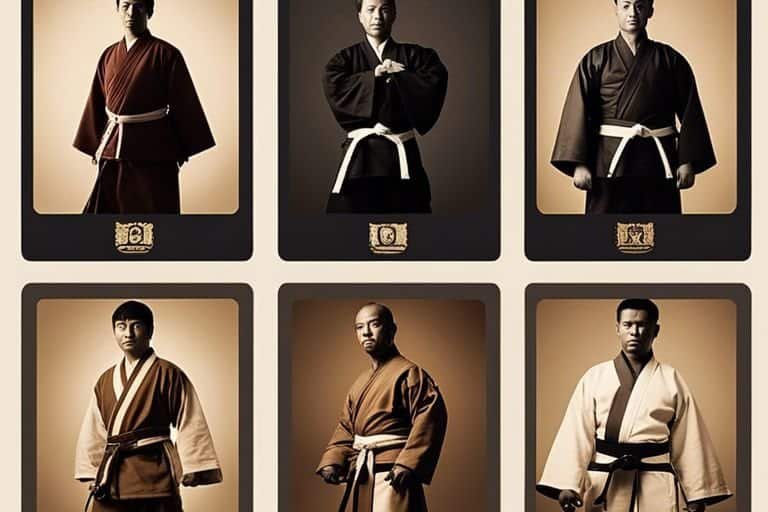The mysterious origins of martial arts belt ranking systems have captivated the curiosity of practitioners and enthusiasts for decades. The progression from white to black belts symbolizes mastery, dedication, and discipline, but few are aware of the fascinating history behind this tradition. Delving into the roots of belt ranking systems unveils intriguing tales of ancient martial arts traditions, rigorous training methods, and the evolution of these systems into the structured format we recognize today. Understanding the story behind the origin of martial arts belt ranking systems sheds light on the transformative influence of this tradition and its significance in the martial arts world.
Key Takeaways:
- Origin: The martial arts belt ranking system is believed to have originated in the late 19th and early 20th centuries in Japan, particularly within the context of judo and its founder, Jigoro Kano.
- Progression: The belt ranking system serves as a visual and tangible representation of a practitioner’s skill and mastery within their martial art, providing a clear path for progression and goal-setting.
- Evolution: While the belt ranking system was initially established in Japanese martial arts like judo and karate, it has since been adopted and adapted by various martial arts disciplines around the world, each with its own unique belt colors and criteria for advancement.
Early Martial Arts and the Absence of Belts
If we take a look back in history, we would realize that the concept of belt ranking system in martial arts is a relatively modern phenomenon. In fact, in the early days of martial arts, there were no colored belts or ranking systems to denote a practitioner’s level of expertise. The absence of belts in martial arts is a testament to the ancient origins of these disciplines and the traditional ways in which they were taught and mastered.
The Origins of Martial Arts
Arts such as karate, judo, and taekwondo have roots that date back centuries, originating in countries such as Japan, China, and Korea. These martial arts were passed down from generation to generation, often through oral tradition and practical training. Over time, these ancient fighting techniques evolved into formalized systems of combat and self-defense, each with its own set of philosophies and principles.
The depth and breadth of martial arts knowledge were traditionally gauged through individual assessment and practical demonstrations, rather than a uniform ranking system. The emphasis was placed on the practitioner’s skill, discipline, and commitment to the art, rather than a specific belt color.
Training and Mastery Before Belt Systems
Belt ranking systems as we know them today did not exist in the early days of martial arts. Instead, students of martial arts would undergo rigorous training, discipline, and practical application of techniques to prove their proficiency. Masters and teachers of the art would closely observe their students’ progress and determine their level of expertise based on their performance and knowledge of the art.
This traditional approach to training and mastery focused on the hard work, commitment, and dedication of the practitioner, fostering a deep respect for the art and a sense of responsibility towards its preservation and continued development.

The Birth of the Belt Ranking System
Obviously, the martial arts belt ranking system is a fundamental aspect of many traditional martial arts and plays a crucial role in the progression and development of practitioners. This system, which uses colored belts to signify the rank and skill level of the practitioner, has a rich history that dates back to ancient times.
Jigoro Kano: The Father of the Judo Ranking System
Ranking systems in martial arts were revolutionized by Jigoro Kano, the founder of judo. In the late 19th century, Kano introduced the use of different colored belts to signify the progress of his students. This innovation allowed for a clear and tangible way to measure and acknowledge a practitioner’s skill and knowledge.
One of the key principles behind Kano’s ranking system was the emphasis on continuous improvement and personal development. He believed that the belt ranking system not only provided motivation for practitioners to strive for higher levels of skill, but also instilled a sense of discipline, respect, and humility.
Expansion into Other Martial Arts Forms
With the success of the belt ranking system in judo, other martial arts such as karate, taekwondo, and Brazilian jiu-jitsu adopted similar ranking systems. This allowed for a standardized way to measure and compare the skill levels of practitioners across different martial arts disciplines, further enhancing the credibility and recognition of martial arts as a whole.

Belt Colors and Their Meanings
For centuries, martial arts practitioners have used a system of belt colors to signify their level of expertise and mastery in various disciplines. The belt ranking system plays a crucial role in recognizing a student’s progress and skill level. Each belt color holds a unique significance, representing the journey and dedication of the individual practitioner.
The Significance of Belt Colors
With each belt color in martial arts comes a deeper meaning and symbolism. From the pure white belt symbolizing the beginning of a student’s journey, to the black belt representing mastery and expertise, each color holds its own representation of the practitioner’s progress and growth. The progression through different belt colors signifies the student’s commitment, discipline, and perseverance in mastering the art form. It serves as a visual representation of the individual’s development, both physically and mentally, as they advance through the ranks.
The Journey from White to Black Belt
From the moment a student ties on their white belt, they embark on a journey of continuous learning and self-improvement. The transition from white to black belt is a transformative experience that requires dedication, resilience, and unwavering determination. As the student progresses through each successive belt color, they encounter new challenges, honing their skills and developing a deeper understanding of the art form. The attainment of a black belt is not merely a reflection of technical skill, but an embodiment of the practitioner’s character, perseverance, and indomitable spirit.
Any martial artist can attest to the profound significance of their journey from white to black belt. It is a testament to their commitment to self-improvement, unwavering discipline, and pursuit of excellence in their chosen discipline.
Cultural Impact and Variations
To understand the cultural impact and variations of martial arts belt ranking systems, it is important to delve into the diverse practices and traditions of different martial arts around the world.
Belt Systems Across Different Martial Arts
On the surface, it may appear that all martial arts share the same belt ranking system, with colors ranging from white to black. However, each martial art has its own unique belt system, with varying colors, number of ranks, and criteria for advancement. For example, in Brazilian Jiu-Jitsu, a blue belt signifies a high level of technical knowledge and the ability to apply techniques effectively in live sparring, while in Taekwondo, a blue belt may indicate intermediate proficiency in basic techniques and forms. The differences in belt systems reflect the diverse histories and philosophies of different martial arts.
On a broader scale, the concept of belt ranking has been adopted and adapted by martial arts around the world, including disciplines that traditionally did not use a belt system. The globalization of martial arts has led to the incorporation of belt rankings in disciplines such as Muay Thai and Krav Maga, which historically did not have a formal belt system. This global influence has both positive and negative aspects, as it promotes standardization and recognition of skill levels, but can also lead to commercialization and dilution of traditional practices.
Variations in belt systems and the global spread of belt rankings have sparked debates within the martial arts community, with some advocating for preserving traditional systems and others embracing the evolution of martial arts in a modern, interconnected world.
Final Words
Hence, the origin of the martial arts belt ranking system stems from its roots in Japanese martial arts, particularly Judo, and was later adopted by other martial arts such as Karate and Taekwondo. The belt ranking system was developed as a way to track and signify a student’s progress and skill level, providing a clear hierarchy within the martial arts community. Over time, the system has evolved to incorporate a range of belt colors and degrees, reflecting the diverse skill levels and achievements of practitioners. The belt ranking system continues to be an integral part of martial arts training, serving as a motivational tool and a symbol of dedication and perseverance.
FAQ
Q: What is the origin of martial arts belt ranking systems?
A: The origin of martial arts belt ranking systems can be traced back to the founder of Judo, Jigoro Kano, who introduced the concept in the 1880s as a way to indicate the skill level of his students. The system was later adopted and adapted by other martial arts, such as Karate and Taekwondo.
Q: How are belt ranks determined in martial arts?
A: Belt ranks in martial arts are typically determined through a combination of skill, knowledge, and character. Students must demonstrate proficiency in techniques, forms, sparring, and self-discipline, as well as show respect for the art and its traditions.
Q: What do different belt colors signify in martial arts?
A: In most martial arts, the color of a belt signifies the level of experience and expertise of the practitioner. Generally, white belts represent beginners, while black belts signify advanced students. Intermediate ranks are often denoted by colors such as yellow, orange, green, blue, and brown.
Q: Why are there different belt ranking systems in different martial arts?
A: Different martial arts have their own unique histories, traditions, and philosophies, which have influenced the development of their specific belt ranking systems. While many share common principles, each art may place different emphasis on certain aspects of training, resulting in variations in the structure and criteria for belt advancement.
Q: What is the significance of belt ranking systems in martial arts?
A: The belt ranking system serves several purposes in martial arts, including providing a tangible goal for students to strive for, establishing a clear path for progression, and recognizing and rewarding their dedication and skill. It also helps maintain a standard of quality and proficiency within a martial art discipline.



